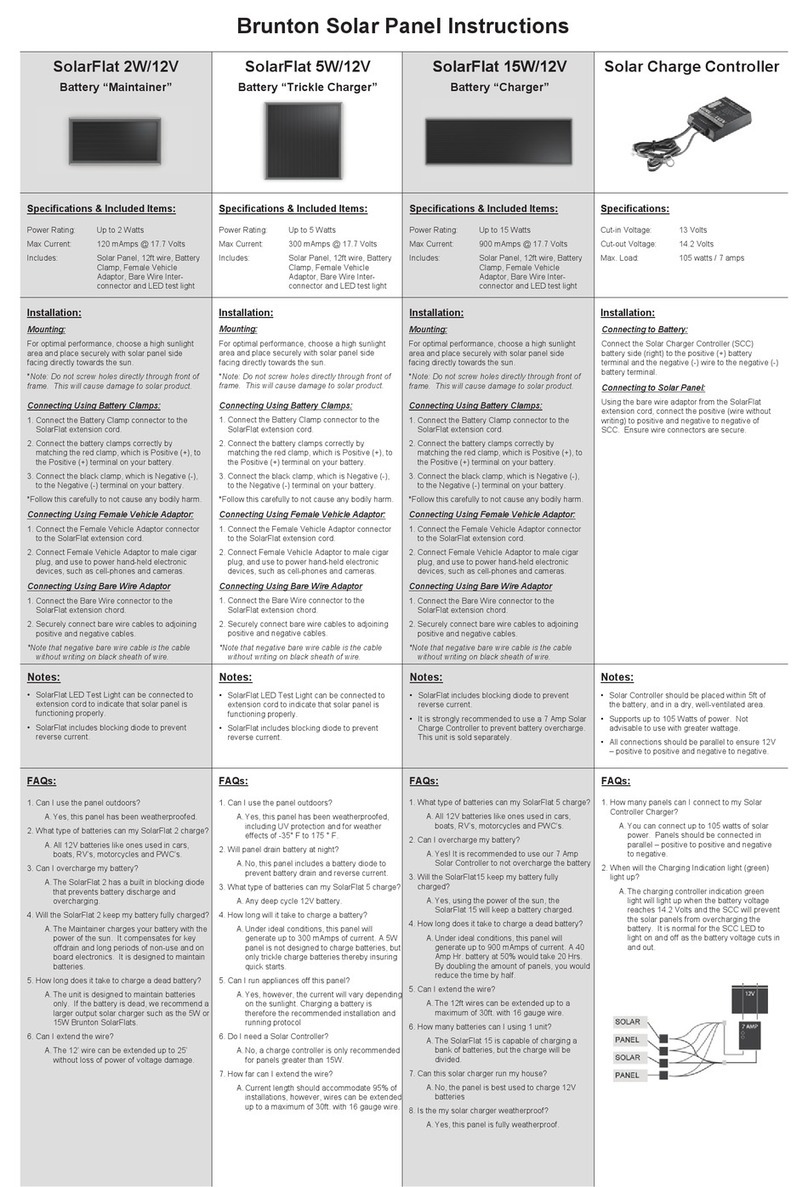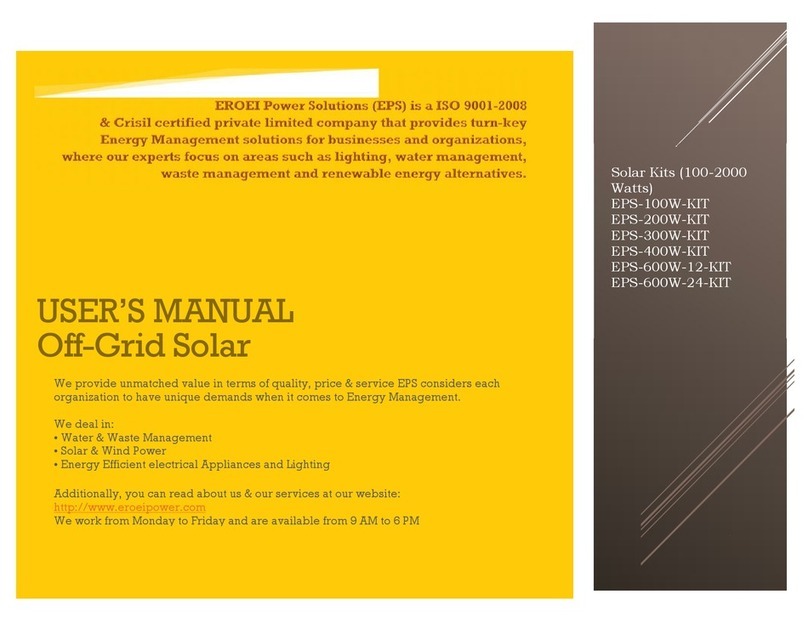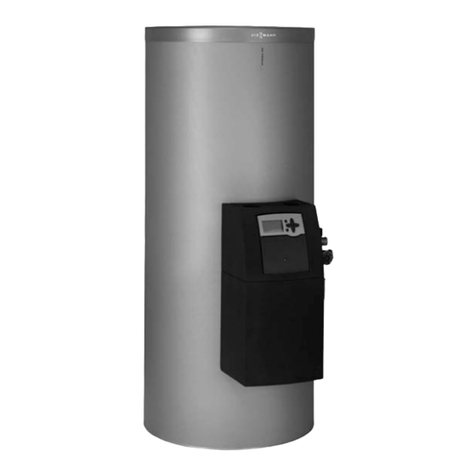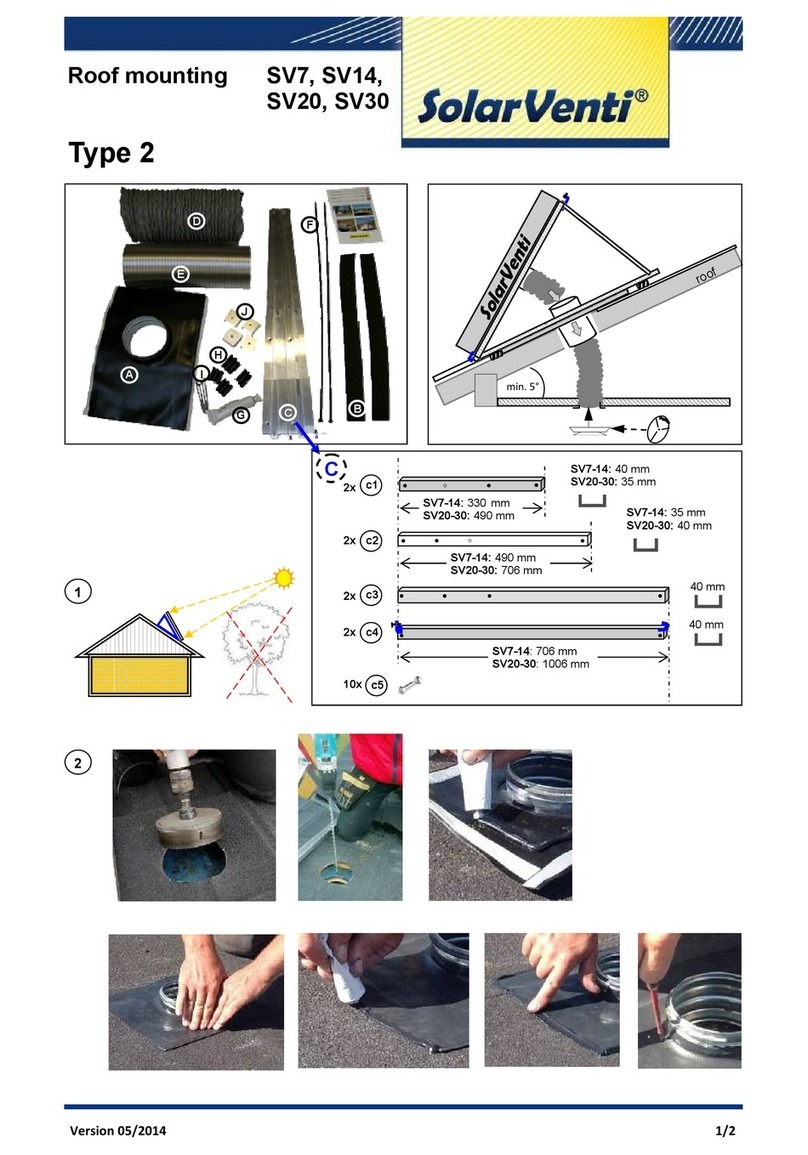Nedap PowerRouter PR30S Instruction Manual

1
PowerRouter application guideline
Technical information about a self-use installation

2
Contents
Introduction ..................................................................................................................... 3
Step 1. Assembly............................................................................................................. 4
Step 2. PowerRouter AC connection............................................................................... 5
External relay for the backup power supply .................................................................... 8
External relay for load management................................................................................ 9
Step 3: Connecting the sensor...................................................................................... 11
Step 4: Connecting the solar strings ............................................................................. 14
Step 5: Connecting the batteries................................................................................... 17
Step 6: Connecting the internet connection.................................................................. 23
Step 7: Initialising the PowerRouter............................................................................... 25
Three-phase self-use system ........................................................................................ 27
Glossary ........................................................................................................................ 28

3
Introduction
This document explains, step-by-step, how to install a PowerRouter with batteries (PowerRouter Solar Battery
– PRxxSB-BS) to create a self-use system. It also describes important aspects that must be considered during
installation.
The steps in this document are based on the standard procedure for connecting the system. Detailed
information about the installation can be found in the installation manual that comes with the PowerRouter. That
manual can be downloaded from www.PowerRouter.com. Nedap recommends you read this manual thoroughly
before beginning the installation.
If you have any questions during con guration and installation, please get in touch with your local PowerRouter
Business Partner.
The PowerRouter is intended for use in a single-family household with a maximum service entrance rating of
13.8 kVA. The PowerRouter is the core element of the self-use system, as shown in the following section.
Figure 1: Schematic depiction of a self-use system with PowerRouter
017763
017763
LOCAL OUT

4
Step 1. Assembly
Important considerations
> The ingress protection rating of the PowerRouter is IP20 (protected against objects >12.5 mm; not protected
against water)
> The PowerRouter must be installed in a well-ventilated room in which the temperature is maintained between
-10 and 40 °C.
> Maintain a gap of 30 cm above and below the PowerRouter to allow sufcient ventilation.
> Maintain a gap of 80 cm above and below the PowerRouter when two systems are mounted one above the
other.
First attach the supplied mounting bracket to the wall. A drill template is provided to help you determine where
the holes are to be drilled for the mounting bracket. Use mounting hardware suitable for the wall to which the
PowerRouter is being attached.
Attach the PowerRouter to the bracket, as shown below.
Figure 2: Attaching the PowerRouter to the mounting bracket
4 x
2 x
Drill template the PowerRouter

5
Step 2. PowerRouter AC connection
The PowerRouter is a 1-phase inverter that is connected to the utility grid via the ‘AC grid’ connection. Figure
3 is a simplied technical diagram of a self-use system based on the PowerRouter. Although not shown in this
drawing, circuit breakers and a master switch must be installed.
The PV counter, designed as an optional extra for the PowerRouter, registers the amount of energy derived from
the PowerRouter. The amount of energy fed into the grid and the amount used from the grid are measured using
the bi-directional (generation/consumption) meter. These three values enable you to calculate the percentage of
self-use.
Figure 3: Technical diagram of a self-use system
0 1 7 7 6 3
0 1 7 7 6 3
AC GRID CAN
300A
25A
16A
Sensor

6
Optional backup power supply
The PowerRouter provides users with a self-use system with backup power supply which intervenes in the
event of a power outage. The PowerRouter has two AC connections: an AC GRID and an active AC LOCAL
OUT. In the event of a grid failure, the PowerRouter will switch selected loads over to AC LOCAL OUT via an
external 230V relay*, providing them with power.
*Recommended external relay UK: chint – NCI – 9508 – 230 VAC or an equivalent type
Recommended external relay rest of Europe: PRA1RLY available from your local PowerRouter distributor
The mains power supplied to the PowerRouter is connected to the AC GRID terminal (see gure 4) and must be
between 180 and 264 VAC at a frequency of 45 to 55 Hz. Backup power is provided from the AC LOCAL OUT
connection, and the attached electrical load must be one or more 1-phase devices.
017763
017763
AC
GRID CAN
AC
LOCAL
OUT
300A
25A 25A
230 Vac
95A
16A
Figure 4: Connection diagram for a 1-phase self-use system with backup power supply
Sensor

7
Earthing and current system
The PowerRouter is compliant with the following
earthing systems: TN-S, TN-C, TNC-S or TT.
AC fuse
Nedap recommends that you add a 16 A circuit breaker
with B or (preferably) C characteristics to the AC GRID
line connection between the PowerRouter and the
electric utility meter. We also recommend installing the
same type of 16 A circuit breaker in the AC LOCAL OUT
line connection. It must be possible for the installation
engineer to switch off the circuit breakers to de-
energise the PowerRouter so work on the system can
be performed safely.
RCD rating PowerRouter type
16 A PR30S
PR30SB-BS
PR37S
PR37SB-BS
25 A PR50S
PR50SB-BS
Cable cross section
Nedap recommends you to connect the PowerRouter in the vicinity of the grid connection and use copper
cables with a minimum cross section of 4 mm2. This eliminates unnecessary losses in the internal system and
also prevents voltage disconnects caused by high grid impedance when supplying a high output current.
The diagram below shows that the PowerRouter must increase the AC voltage in order to feed the generated
electricity into the grid. This is because the impedance of the cable to the on-street transformer plays an
important role in this. However, the home installation is connected to the PowerRouter, so the voltage should
never be too high. The PowerRouter software will decrease the output current when this nears the maximum
permissible voltage (cut-off limit). This functionality is added to avoid any unnecessary cut-off in the event of an
ineffective AC grid.
Figure 6: In uence of grid impedance on AC voltage
Figure 5: AC connection terminals on the PowerRouter
NNL
L
AC GRID AC LOCAL OUT
NO NO
NC NC
250 V
230 V
Street transformer
Grid impedance20A
20V
1Ω

8
External relay for the backup power supply
Connecting an external relay
Through use of an external relay, some of the single
phase loads can be connected to the AC LOCAL OUT
connection on the PowerRouter, which provides backup
power during a power outage. This creates a backup
system with a switch-over time of ≥ 1 second providing
the connected loads with an backup with a stable 230
VAC/50 Hz output. The power provided during a power
outage comes simultaneously from the solar energy
that is being generated at that moment and from the
batteries. It is important to note, however, that only
a portion of the loads can be supplied with backup
power, because the reserve capacity of a self-use
system is limited by the available solar energy and the
size of the battery bank.
A benecial aspect of this switching conguration is
that loads draw power from the grid whenever the
PowerRouter is restarted or in standby.
The PowerRouter has two sets of congurable potential-free contacts. When a grid outage occurs, loads are
switched to backup power via an external relay. An advantage to this system is that there is no current owing
through the relay coil during normal use. In addition, the PowerRouter controls the exact moment of switch-
over, which enables it to bring the current provided at AC LOCAL OUT into synch with the mains current as
the grid power is restored. Another advantage is that delay times can be congured, using the PowerRouter
Software Installation Tool*. This makes it possible to prevent the backup power provision from responding to
brief power interruptions (brown-outs).
*For more information about the settings, please consult the PowerRouter application guideline - Software Installation Tool, which you can
download from our website.
Technical data - external relay
The external relay can be any standard, commercially available relay with the technical specications shown
below.
Europe except UK UK
> Coil voltage: 230 VAC > Coil voltage: 230 VAC
> Contact ratings: 40 A for both N/O and N/C contacts > Contact ratings: 95 A for both N/O and N/C contacts
> Contact conguration: 2 contacts, or 2 N/Os and 2 N/Cs > Contact conguration: 2 contacts, or 2 N/Os and 2 N/Cs
> Contact gap: ≥ 3.2 mm > Contact gap: ≥ 3.2 mm
As indicated in the picture above, only single-phase consumers can be connected to AC LOCAL OUT. When
producing backup power, the PowerRouter generates its own AC output which cannot be synchronised with the
other two phases.
Figure 7: Connecting an external relay for backup power
0 1 7 7 6 3
0 1 7 7 6 3
tuolacolCAdirgCA
L3
NLNCNO
NL
L2L1N
L3
R1 R2
3 4
L2
L1
L
N
N
R7 R8
5 6
A1 A2

9
External relay for load management
Connecting the external relay
To increase self-use it is possible to have the PowerRouter
automatically connect larger loads when excess solar
energy is available. Below is a circuit diagram which
shows how the external relay (p/n PRA1RLY) is controlled
by one set of potential-free contacts.
Activating load management
Load management is activated using the Software
Installation Tool. This is done by conguring the
parameters as shown below. These values are based
on the capacity being fed into the grid, which means
that this is power above and beyond what is being used
to charge the battery.
A: The capacity of the consumer to be connected when
extra solar energy is available that is not being used
to charge the battery.
B: The percentage of value A that must be available
before the load will be connected. In this example
the extra load will be connected once at least 100%
of 500 W is being fed back into the grid.
C: The percentage of value A at which the load will
be disconnected (can be set at 20-200%). In this
example, the extra load will be disconnected once
the excess power falls below 20% of 500 W.
D: Delay in seconds before the load is switched on,
once the activation conditions have been met (0-100
seconds).
E: Delay in seconds before the load is switched off,
once the deactivation conditions have been met (0-
100 seconds).
F: The maximum time the load will remain connected,
regardless of the available solar power.
G: The minimum time the load will remain connected,
regardless of the available solar power. Figure 9: Activate load management
Figure 8: Connecting an external relay for load management
0 1 7 7 6 3
0 1 7 7 6 3
AC grid
L3
NCNO
NL
L2L1N
L3
3 4
R1 R2
L2
L1
L
N
N
5 6
R7 R8
A1 A2

10
Connecting alarm to potential-free contact
Once the alarm settings have been congured, the
alarm must be assigned to a set of potential-free
contacts. The terminals for these contacts are labelled
K201 (relay 1) and K202 (relay 2) and are located to the
right of the AC LOCAL OUT connection.
The potential-free contact can be activated in two ways:
1. Normal: The contact closes when the alarm is
activated and opens when the alarm is deactivated.
2. Pulse: The contact opens and closes at the selected
frequency for the congured length of time when the
alarm is activated and does so again when the alarm
is deactivated.
Figure 10: Relay 1 of 2

11
Step 3: Connecting the sensor
The 1-phase sensor (p/n PRA1SENSE) or the 3-phase sensor (p/n PRA3SENSE) measures the ow of current
to and from the public electricity grid. This enables the PowerRouter to measure the demand from the loads
and detect the amount of power being supplied to the grid. When the battery is not fully charged, priority is
rst given to charging the battery. During the evening and night, when no solar power is being generated, the
power needed for the loads in the home is drawn from the battery. The grid and the loads are connected to the
PowerRouter’s AC GRID connection via a parallel switch.
1-phase sensor for consumption monitoring
Figure 11: Position of the 1-phase sensor in the self-use system
It is possible to connect a 1-phase sensor to the PowerRouter Solar Inverter (PRxxS) to measure single-phase
consumption. It is also possible to connect a 3-phase sensor to the PowerRouter Solar Inverter.
The 1-phase sensor must be connected to the external line (L) conductor at a point where it is possible to
measure the electricity owing towards the utility grid. The sensor will only work correctly if the arrow on the
sensor is pointing towards the utility grid.
Sensor
AC Grid
N L
0 1 7 7 6 3
0 1 7 7 6 3
N
L
N L

12
Figure 12: 1-phase sensor Figure 13: Connecting the 1-phase sensor
The cable on the sensor is terminated with an RJ45 plug, which must be inserted into the PowerRouter’s CAN
terminal. The sensor must be connected to the lower RJ45 socket, which is covered by a blind hole cover (see
Figure 13). Remove the blind hole cover and insert the RJ45 plug in the socket. The standard cable length is 1
metre, but it can be extended with a CAT-5e cable having a maximum length of 10 metres by means of a CAT-
5e cable coupling.
Figure 14: CAT-5e coupling Figure 15: CAT-5e cable
Important information about the 3-phase grid connection
When a 3-phase grid connection is available the sensor must be connected to the same external conductor to
which the PowerRouter is connected. During initialisation of the system, sensor operation is tested to ensure
that the system is connected correctly. If the current sensor is not connected correctly, code P105H will appear
on the display.

13
3-phase sensor
With a 3-phase sensor, load demand can be measured for all three phases at the same time. When used
with a generation/consumption meter that is capable of two-way communication, this makes it possible to
compensate for consumption on one phase by feeding power into the grid on the other two phases.
With this two-way communication, all power ows can be added together, so the meter indicates the total
positive or negative balance. In the example below, there is 2.5 kW of consumption and 2 kW of generation,
so the meter indicates 0.5 kW of consumption from the grid. The 2 kW of available generated power is fed into
the grid on phase 1 to compensate for the consumption drawn from phases 2 and 3. This method enables the
1-phase PowerRouter to work as a 3-phase system.
Figure 16 : How a meter with two-way communication works
The 3-phase sensor must be connected to the home wiring connected directly to the generation/consumption
meter, before any branches to consumers in the house. The PowerRouter uses the sensor to measures the
amount of energy being consumed at any moment on any phase.
The PowerRouter only works with this type of 3-phase sensor (p/n PRA3SENSE), and a 3-phase sensor can
only be connected to one PowerRouter.
Figure 17: Connecting a 3-phase sensor
Note: For a more detailed explanation of how to connect the 3-phase sensor, please refer to the manual
included with the 3-phase sensor.
Import
kWh
kWh
Export
0.0
0.5
1 kW1,5 kW2 kW
Import
kWh
kWh
Export
1.5
0
1 kW1,5 kW4 kW
41 Green/white wire 42 Green wire 43 Orange/white wire
11 N
fuse 315 mA
to the grid
to the installation
1 L1
4 L2
7 L3
9 L3
6 L2
3 L1
fuse 315 mA
to the grid
to the installaon
0 1 7 7 6 3
0 1 7 7 6 3
NL1L2
SENSOR
369
1
11 4 7
Fuse
315 mA
L3
L1L2L3

14
Step 4: Connecting the solar strings
Because the PowerRouter’s photovoltaic connections are electrically isolated from the AC section, the
PowerRouter can be used with all kinds of solar modules and a wide range of input voltages.
Modules that can be connected to the PowerRouter:
> Monocrystalline modules
> Polycrystalline modules
> Thin-layered or amorphous modules
The 3.7 and 5 kW versions of the PowerRouter have two isolated photovoltaic connections. The 3kW version
only has one photovoltaic connection. MC4 connectors are used for the photovoltaic connections on the
PowerRouter. Each photovoltaic connection has its own MPP tracker in order to maximise the output from the
modules.
Figure 18: Photovoltaic connections on the PowerRouter
Each input has a wide open-circuit voltage (VOC) range of 150-600 VDC and is designed for a maximum input
current of 15 A. Warning: The 600 VDC threshold must never be exceeded. If the 15 A is exceeded, the solar
input will limit the current.
In the morning, the PowerRouter switches on at around 150 VDC with a power of 40 W based on 2 solar inputs.
After switching on, the MPP tracker seeks to provide the best possible power output level; it does so at a
voltage level of 100- 480 VDC.
The optium MMP-voltage for each string input of the PowerRouter at 25°C ambient temperature is 330Vmmp.
The two solar inputs can be used non-symmetrically (e.g. input 1 at 2kWp, input 2 at 4 kWp), but the maximum
solar output fed to both inputs at any given moment is limited to 6 kW. If too much current is being supplied, the
MPP point will be adjusted to limit the solar power. In the event of gradual changes >6kW (cloud in front of the
sun), a power-overload message will appear on the display of the PowerRouter and via myPowerRouter.com.

15
Connecting the photovoltaic modules
To optimally congure the solar modules, take a look at our PV calculation tool (available online at
www.PowerRouter.com/calculator). You can choose the PowerRouter version and photovoltaic modules you are
using. The calculator tool then calculates the correct string conguration for this combination.
Solar cables
Photovoltaic modules often come with short cable connections (usually Ø 4 mm2) with MC4 connectors. If
the total length of the free running cable between the modules and the PowerRouter is less than 50 m, Nedap
recommends that you use a double-insulated solar cable with a diameter of 4 mm2. If the length exceeds 50 m,
we recommend you use 6 mm2cables.
Warning: The plus and minus cables must not be run in the same conduit.
Earthing photovoltaic modules
Earthing varies according to the type of photovoltaic module in use and is different for the xed frame and thin
lm types.
The contact protection on the metal frame and the frame surrounding the photovoltaic module has a
considerable bearing on safety. Nedap therefore recommends that you connect the metal frame to earth.
The PowerRouter has an earthing bonding terminal to which an earth cable can also be connected. Since the
photovoltaic section of the PowerRouter is also electrically isolated from the AC part, ESD spikes do not affect
operation of the PowerRouter.
Thin lm modules produced by various manufacturers are earthed in different ways; consult the manufacturer’s
specications. For this type of module, one of the connections must be earthed. Depending on the brand/
manufacturer, it may be the frame or the ‘+’ or ‘-’ terminal that is to be earthed. These photovoltaic modules
will degrade more quickly if they are not connected to earth. The PowerRouter has been designed with this in
mind: it has an earth connection between the photovoltaic connections. Figure 19 provides an overview of the
possible earthing congurations.
In the case of negative earthing, only 1 ‘-’ input needs to be earthed, because the 2 ‘-’ inputs are connected
together inside the PowerRouter. In the case of positive earthing, the special adapted shown in the gure below
must be connected to the two inputs.
Figure 19: Ground connection possibilities for photovoltaic modules

16
DC disconnection switch
Since the voltage across the photovoltaic connections can be very high, it is important that the PowerRouter
can be disconnected from the photovoltaic modules for assembly or maintenance or in an emergency. A DC
switch is located on the back side of the PowerRouter. On PowerRouters with two photovoltaic inputs, this
switch disconnects both at the same time.
Figure 20: DC disconnection switch on the PowerRouter

17
Step 5: Connecting the batteries
The PowerRouter has an integrated intelligent 24 Vdc battery manager capable of temperature-compensated
charging based on current and voltage regulation, which extends the life of the batteries and improves the
charging process of the batteries. This way it also ensures the safety.
Suitable types of battery
Different types of battery can be connected to the PowerRouter.
Sealed lead-acid batteries
Sealed lead-acid batteries offer good value for the money. These batteries are available in a 2 V version as
well as versions that produce a higher voltage (e.g. 12 V), which are made up of multiple 2 V cells. There are
two versions of this battery type: gel-cell batteries (with a gel-like electrolyte) and AGM (Absorbent Glass Mat)
batteries. Both battery types have a sealed construction and are 100% maintenance-free.
Lead-acid wet battery
Lead-acid (wet) batteries are also suitable. However, they require more maintenance than the sealed type: for
instance, they need to be regularly replenished with distilled water. Charging also generates gas. This means
that these batteries must be installed in a well-ventilated room.
Determining the required battery capacity
The purpose of a self-use system is to enable the household to maximise its own use of the solar power it
generates. In other words, the batteries must be able to store enough energy to meet the power requirements
in the home during the evening and night. The average energy consumption during non-daylight hours can be
used to work out the required battery capacity.
The battery capacity can be compared using the calculation tool at www.PowerRouter.com. This tool enables
you to enter the annual consumption and the consumption prole. The energy that will be available with
different battery sizes is shown. The calculation is based on the rule of thumb that 1 kWh is stored for every 100
Ah (24 V) and that a fully-charged battery can be discharged to 50% DOD.
Nedap recommends that you connect a battery of at least 150 Ah at 24 V. The capacity value is specied in the
battery datasheet as a C10 value (the 10 here stands for the time to discharge).
For determining the (optimum) battery capacity it is important to keep three things in mind:
1. Annual household consumption (kWh)
2. Household consumption prole (at home or away during the day)
3. Size of PowerRouter system (kW)
Optimum battery capacity recommendations
5.0 kW PowerRouter Solar Battery Battery bank with a capacity of at least 200 Ah but not more than 600 Ah
3.7 kW PowerRouter Solar Battery Battery bank with a capacity of at least 200 Ah but not more than 500 Ah
3.0 kW PowerRouter Solar Battery Battery bank with a capacity of at least 200 Ah but not more than 400 Ah

18
Batteries from Nedap
Nedap supplies batteries manufactured by Hoppecke. Each battery bank comes complete with external
housing with two fuses and a set of cables. We also supply Enersys batteries which also include a set of cables
and a fuse.
Figure 21: Enersys type SBS 190F Figure 22: Hoppecke type OPzV
Battery service life
A battery’s service life is usually expressed in terms of the number of charge/discharge cycles and the depth
of discharge (DOD) value. The number of charge/discharge cycles is high for self-consumption, since energy
is drawn from the battery every night. The number of achievable battery cycles drops the higher the depth
of discharge (see chart). For this reason, the PowerRouter is con gured to limit discharge to 50% by default.
Determination of a battery’s service life should be based on the manufacturer’s speci cations. A graph like the
one shown below ( gure 23) is usually provided to indicate the service life (measured in accordance with IEC
standards).
Looking at the number of cycles, we can assure one cycle per day. This does not include days when the system
is in winter mode. Deducting two months of operation in winter mode, this amounts to 300 cycles per year. A
cycle is understood to be charging from 50% to 100% and discharging to 50% again.
Figure 23: Number of cycles versus DOD value
The display and the graphs for the PowerRouter do not show the depth of discharge (DOD), but rather the
charging status. This is 100% when the battery is fully discharged and 0% when fully charged.
When used for backup power, the battery can discharge to a lower depth than for self-use. At that point more
energy is available from the battery. The DOD can be con gured using the Software Installation Tool.
When using a 3-phase sensor, Nedap recommends limiting the level to which the battery can discharge. This is
to avoid discharging the battery too quickly so that the C10 value no longer applies.
100
0
10000
11000
12000
9000
8000
7000
6000
5000
4000
3000
2000
1000
20 30 40 50 60 70 80 90 100
SBS 190F
OPzV

19
Temperature effects
Ambient temperatures have a large inuence on battery capacity. At low temperatures, the capacity drops
quickly. This is illustrated in gure 24 (capacity of a gel battery). The temperature of the room where the
batteries are installed must therefore be kept above 10 °C.
Maximising battery service life
Batteries must not be left in the discharged state for too long, because doing so reduces their service life. With
this in mind, various protection mechanisms have been built into the PowerRouter.
Maintenance charging
At regular intervals – once every 3 weeks – the battery
is forced to run through the 3-state charging cycle.
If maintenance charging coincides with a request for
self-generated power, charging will take priority. Once
the battery is fully charged and the SOC is 100%,
maintenance charging is complete and the battery
becomes available for self-use again.
Likewise, in the winter mode, this cycle of maintenance
continues. The battery module is activated and the
battery charged to 100%, after which the winter mode
is once again activated.
It is possible to start or stop the maintenance charging
manually in the PowerRouter’s display menu. However,
to achieve the maximum service life from the battery,
this is not recommended.
Winter mode
This mode is for using the batteries in the winter, when
there is less solar output and greater demand. This
annual cycle is shown in gure 25, as the blue line
which represents total household consumption.
Because solar output only now and again exceeds
consumption, full charging of the battery occurs less
frequently. Longer periods without full charging shorten
the service life of the battery. This is the reason for the
winter mode, as this protects the battery and ensures a
longer service life.
The moment the system is switched to winter mode, maintenance charging begins, to fully charge the battery.
Once at maximum charge, the PowerRouter’s battery module is switched off. There is no more self-use from
the battery. The period during which the battery is in the winter mode can be programmed with the installation
tool. The standard period is from 1 December to 1 February. At the end of this period, the system completely
recharges the battery again and it can be used for self-use. It is important to choose this period carefully, taking
into account whether or not the system is equipped with a 3-phase sensor. If it is, consumption will be higher
than for a 1-phase measurement.
Figure 24: Temperature versus battery capacity
Figure 25: Winter mode
800
700
600
500
400
300
200
100
0
jan feb mar apr may jun jul aug sep okt nov dec
Wintermodus Solar

20
When in winter mode, maintenance charging continues to be performed as usual. If the PowerRouter is
congured to perform maintenance charging once every three weeks, the battery will be fully recharged at
this interval. Even in winter mode, the battery is always available to provide backup power. When needed, the
battery is reactivated and then used to provide the backup power.
Battery charging methods
The PowerRouter can be congured to use either of the two available battery charging methods: xed oat
voltage or 3-state adaptive charging. The 3-state adaptive charging method is best suited for rapid battery
charging. This is the best conguration for a self-use system.
3-state adaptive charging
In the rst stage the battery is charged at a high current
until it reaches 70-80% of the battery’s charge capacity
(blue line). The battery voltage (green) rises to the bulk
voltage during this stage. In the second stage, the
voltage applied to the battery remains constant, while
the charging current gradually drops to a quarter of
the bulk current. This stage ends once the battery has
reached approximately 85-90% of its capacity. In stage
3 the charging voltage is reduced to the trickle-charge
voltage and the battery is gradually charged to 100%.
This nal stage lasts the longest.
Battery discharge limiter
To protect the battery against excessive discharge
current, it is possible to limit the discharge power
during self-use. This limit value can be congured in
the Software Installation Tool. The value that should
be set depends on how the batteries are connected
(number of parallel branches). When using batteries
for which the battery supplier species a maximum
discharge rate of 100 A, for example, the limit value for
four 12V batteries connected in two parallel strings of
two should be (2x100Ax24V=) 4800W, but for two 12V
batteries connected in a single string (in series) the
limit value should be just (100Ax24V=) 2400W. When
the system is providing backup power, however, it
temporarily disables the limiter.
Figure 26: 3-state adaptive charging
Figure 27: Battery discharge limiter
12V
12V
12V
12V
100A
100A
200A
Other manuals for PowerRouter PR30S
1
This manual suits for next models
5
Table of contents
Popular Solar Panel manuals by other brands
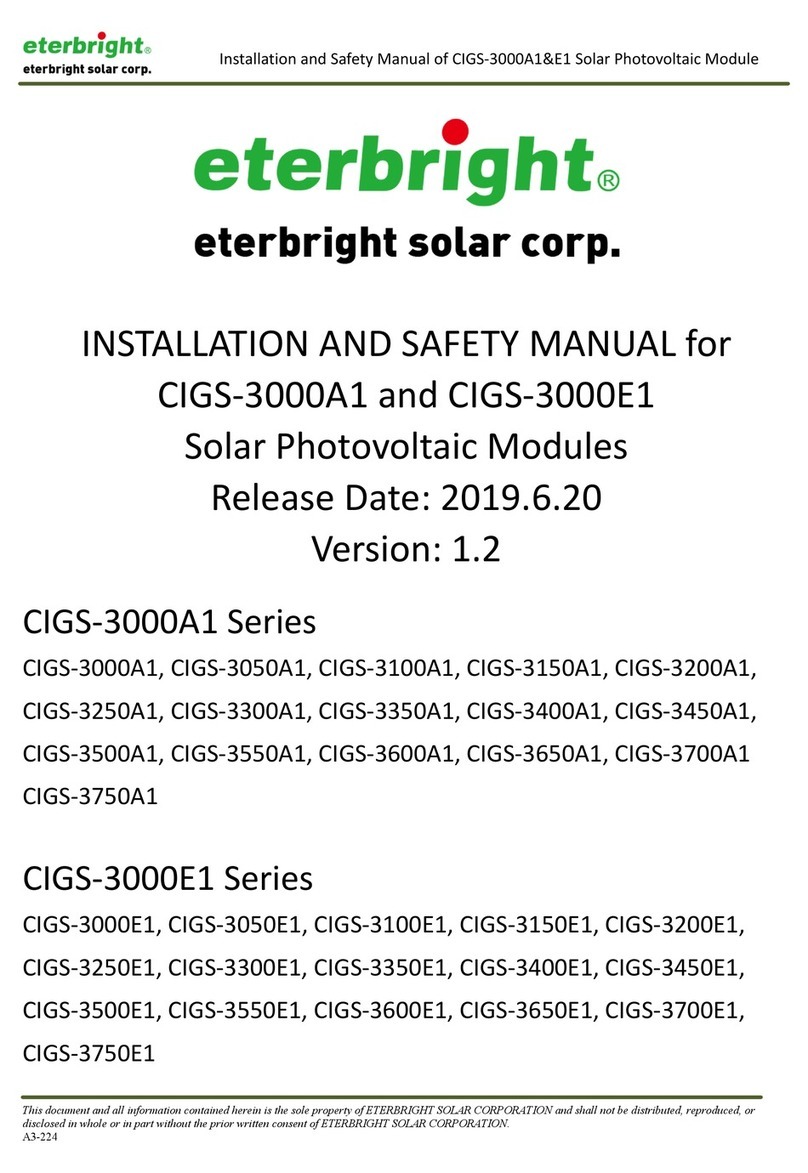
Eterbright
Eterbright CIGS-3000A1 Series Installation and safety manual
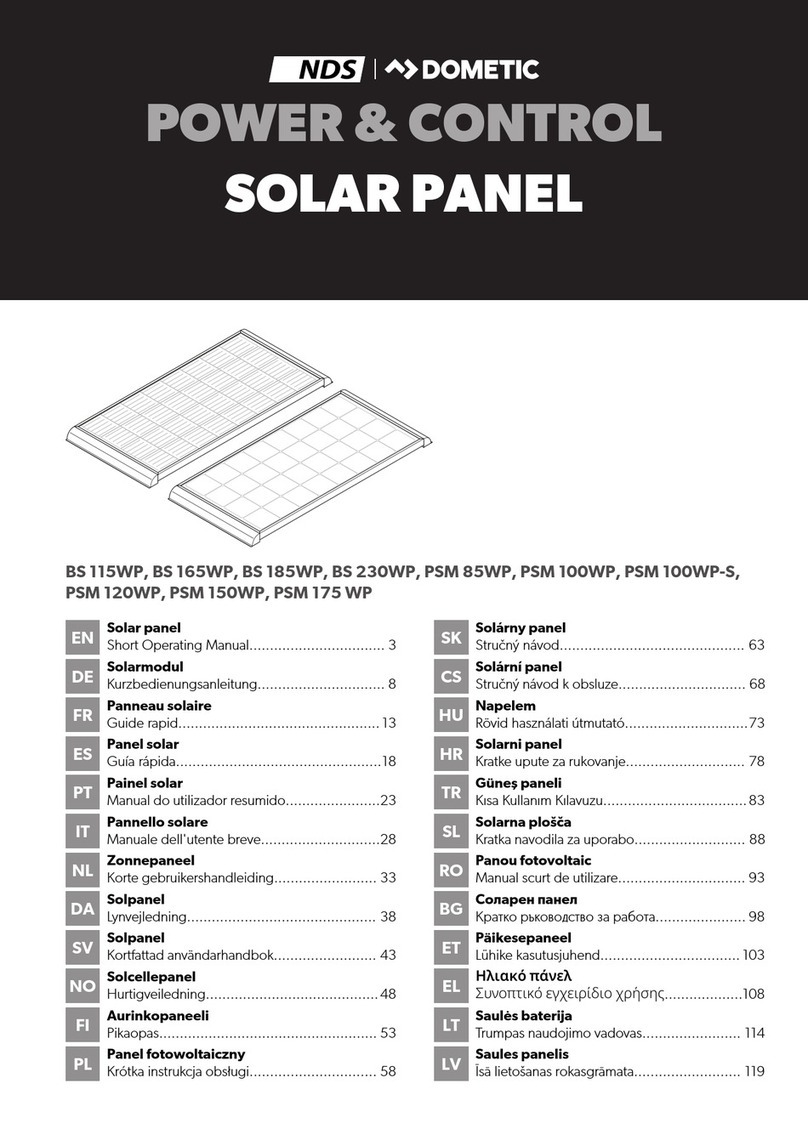
Dometic
Dometic NDS BS 115WP Short Operating Manual
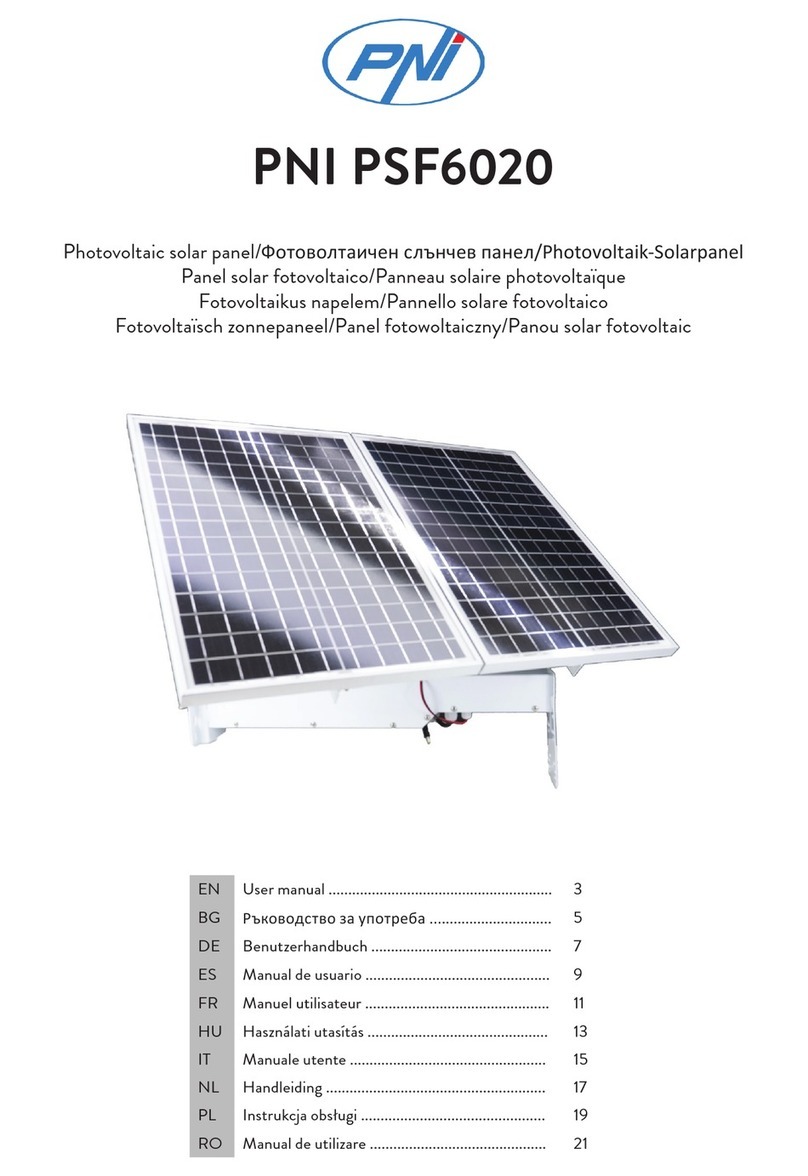
PNI
PNI PSF6020 user manual
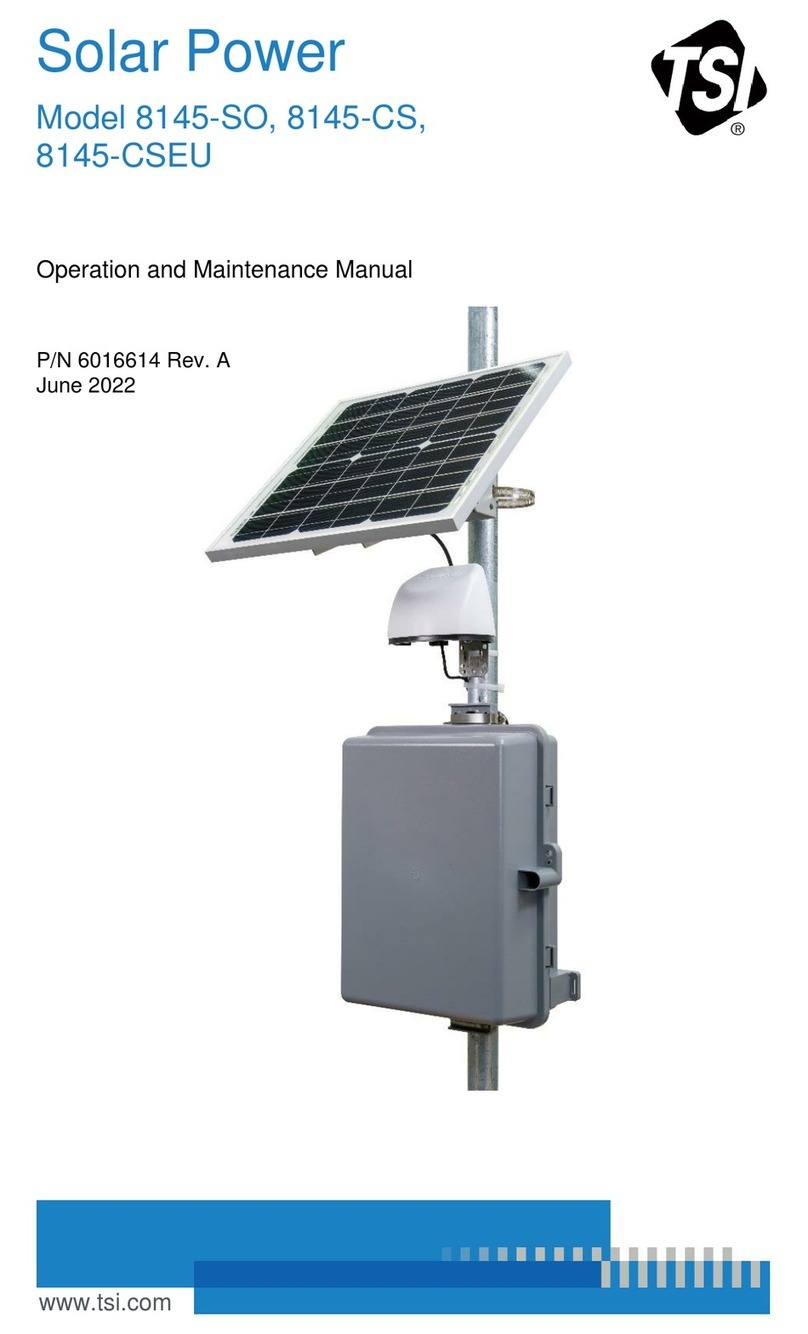
TSI Instruments
TSI Instruments 8145-SO Operation and maintenance manual
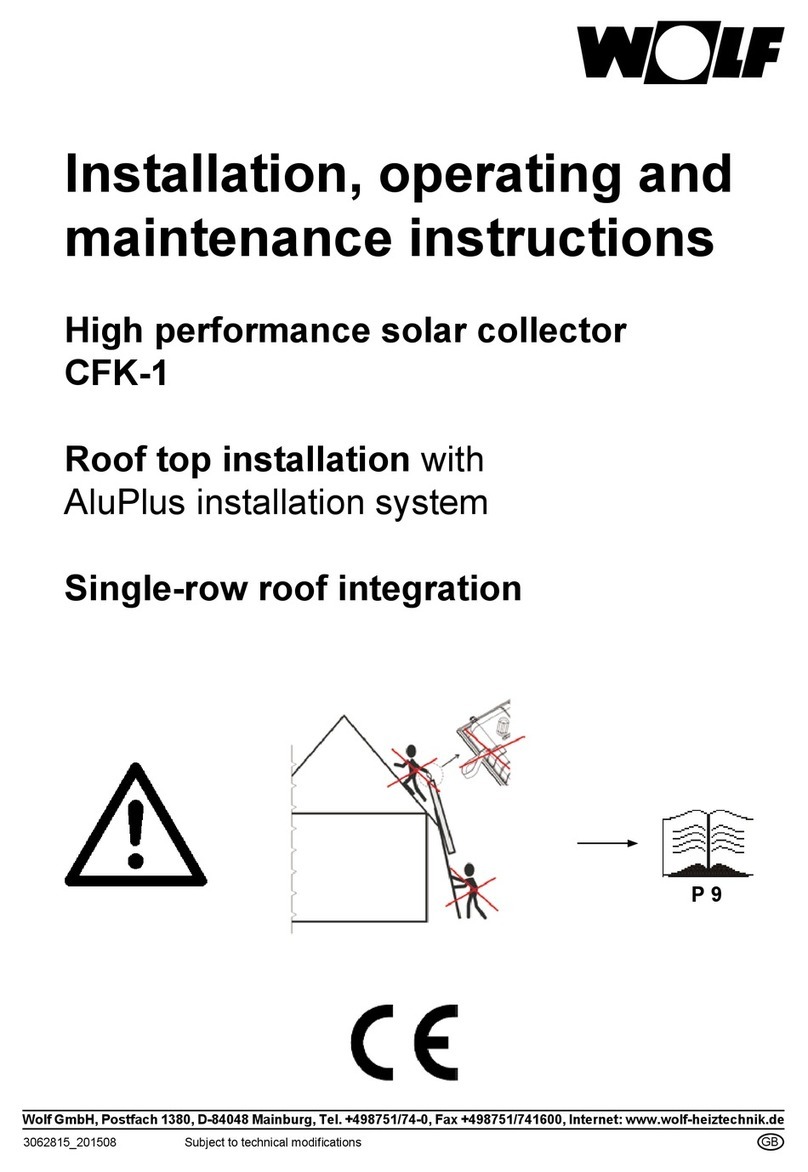
Wolf
Wolf CFK-1 Installation, operating and maintenance instructions
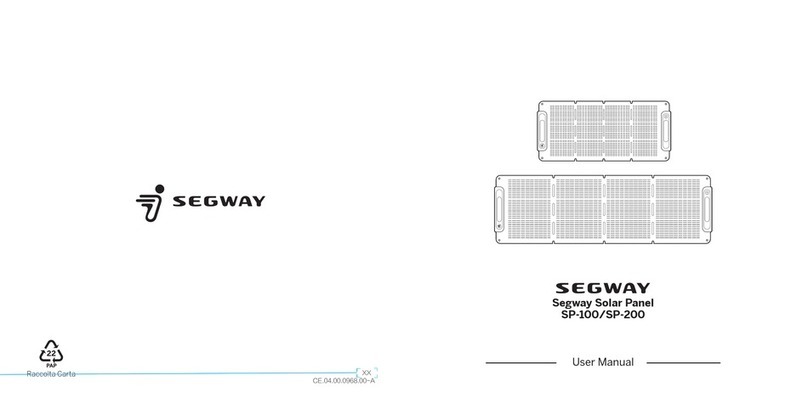
Segway
Segway SP-100 user manual

NexSens
NexSens SP Series quick start guide
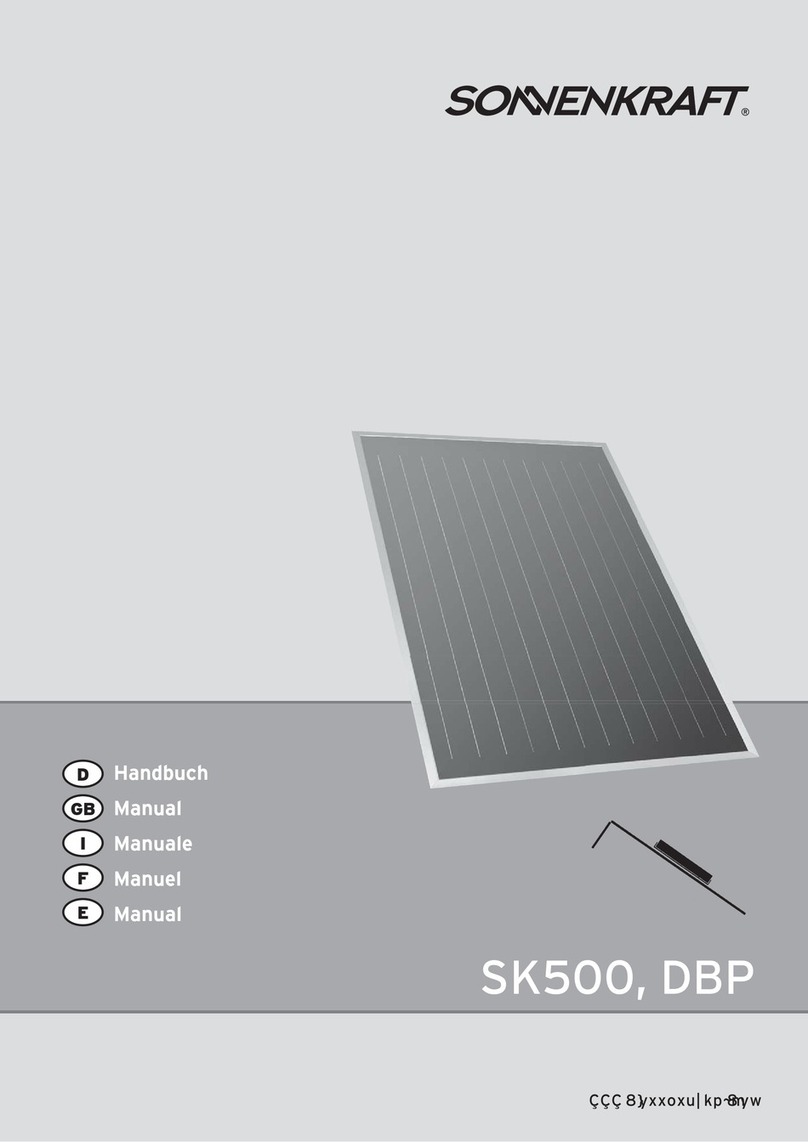
Sonnenkraft
Sonnenkraft SK500 DBP manual
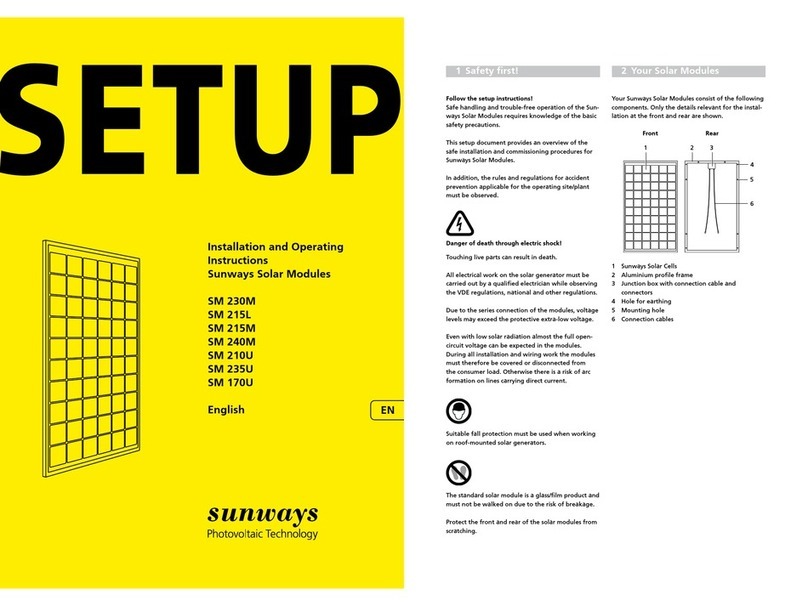
Sunways
Sunways SM 230M Installation and operating instructions
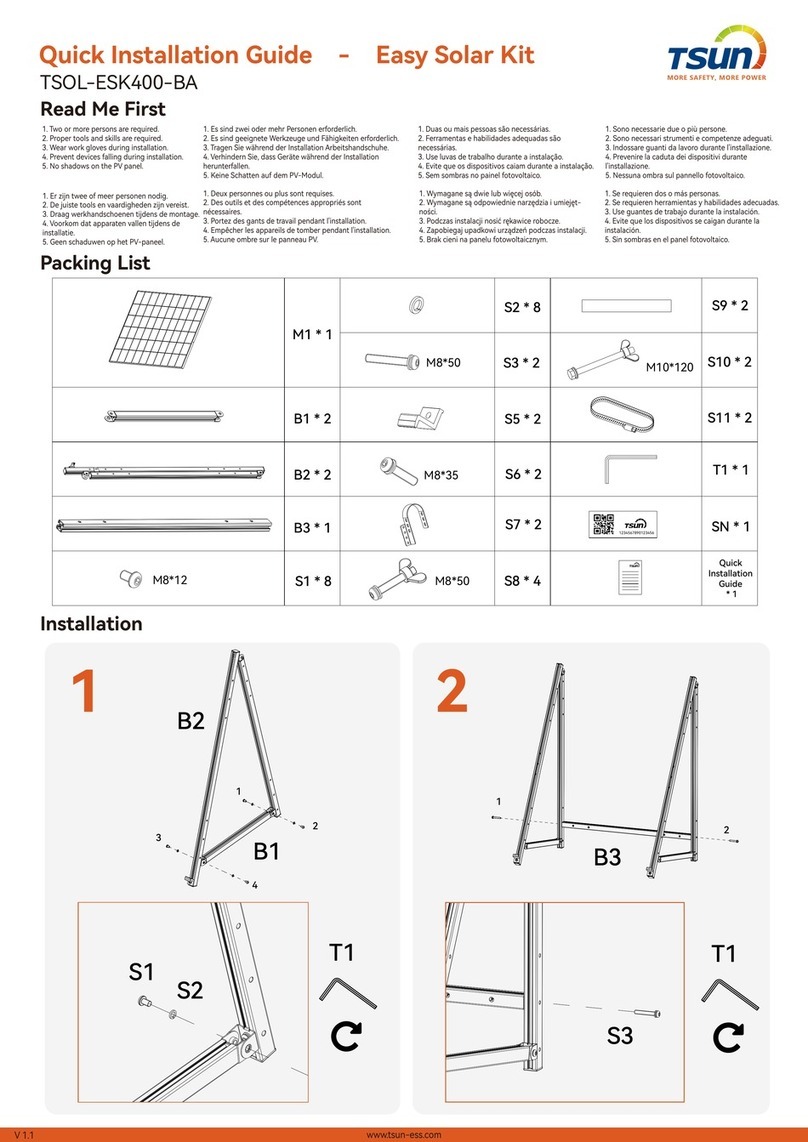
Tsun
Tsun TSOL-ESK400-BA Quick installation guide
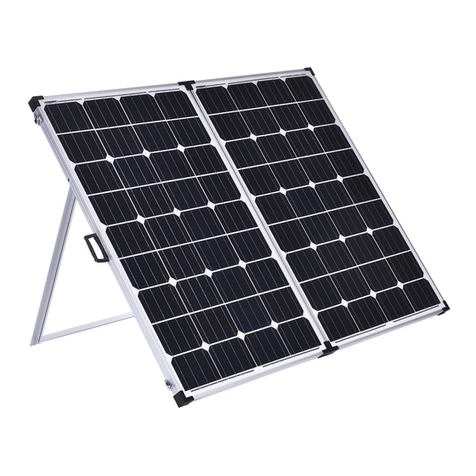
Maxray
Maxray Folding Solar Panel instruction manual
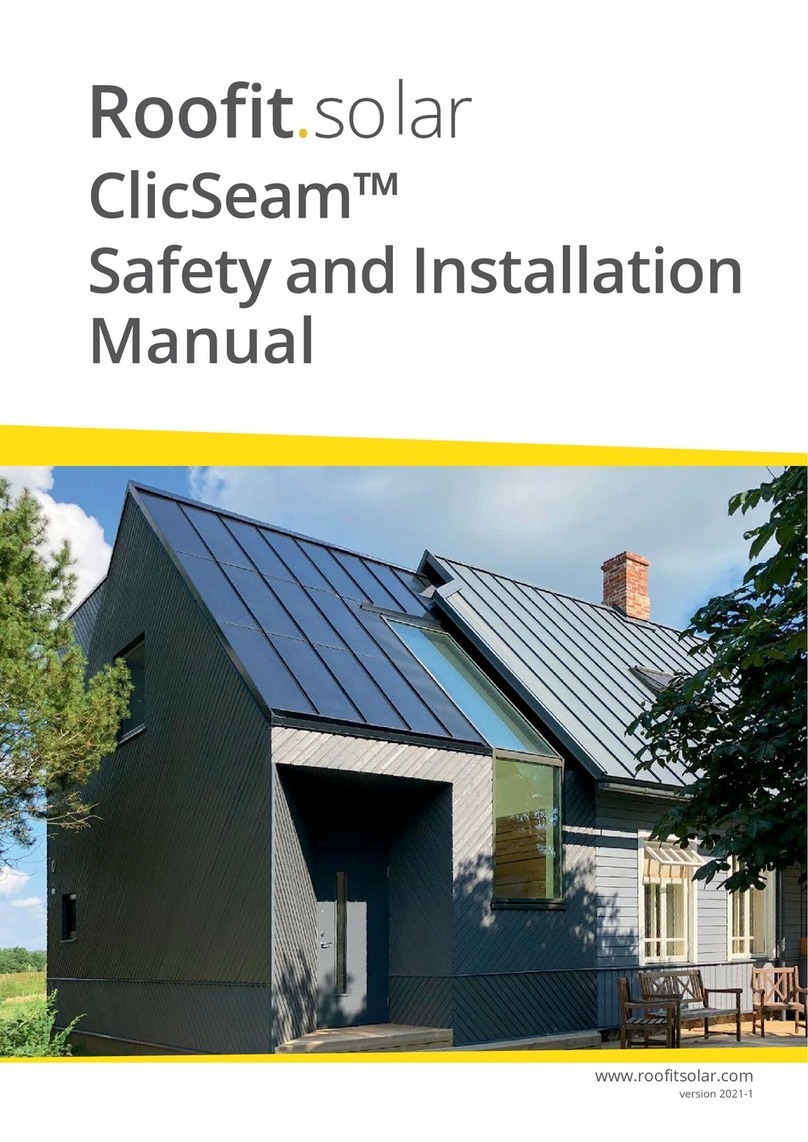
Roofit.Solar
Roofit.Solar ClicSeam Safety and installation manual
